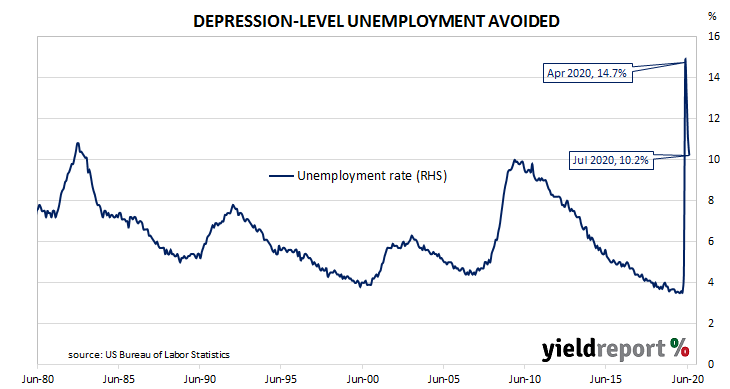Summary: July non-farm payrolls increase lower than June gain; jobless rate down, participation rate down; report viewed as “dated” given weekly initial jobless claim figures; underemployment rate lower, still in mid-teens.
The US economy ceased producing jobs in net terms as infection controls began to be implemented in March. The unemployment rate had been around 3.5% but that changed as job losses began to surge through March and April. May’s non-farm employment report represented a turning point as the US economy began to re-open and the unemployment rate began to fall.
According to the US Bureau of Labor Statistics, the US economy created an additional 1.763 million jobs in the non-farm sector in July. The increase was above the 1.635 million which had been expected but less than the 4.8 million jobs which had been added in June after revisions. Employment figures for May and June were revised up by a total of 17,000.
The unemployment rate dropped from June’s rate of 11.1% to 10.2%. The total number of unemployed decreased by 1.412 million to 16.338 million while the total number of people who are either employed or looking for work decreased by 62,000 to 159.87 million. The fall in the number of people in the labour force lowered the participation rate from June’s rate of 61.5% to 61.4%.
“The data…is seen as dated given the deterioration seen in the high-frequency data to date,” said NAB economist Tapas Strickland.

US Treasury yields increased on the day. By the close of business, the US Treasury 2-year bond yield had crept up 1bp to 0.13%, the 10-year yield had gained 2bps to 0.56% while the 30-year yield finished 3bps higher at 1.23%.
One figure which is indicative of the “spare capacity” of the US employment market is the employment-to-population ratio. This ratio is simply the number of people in work divided by the total US population. It hit a cyclical-low of 58.2 in October 2010 before slowly recovering to just above 61% in late-2019. July’s reading increased for a third consecutive month from 54.6% in June to 55.1%.

